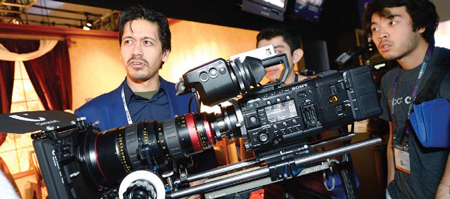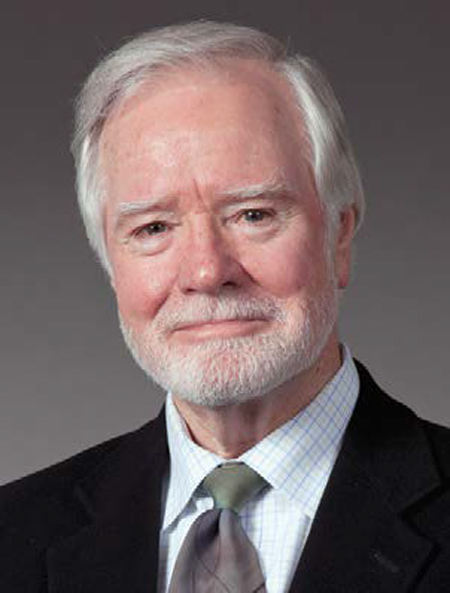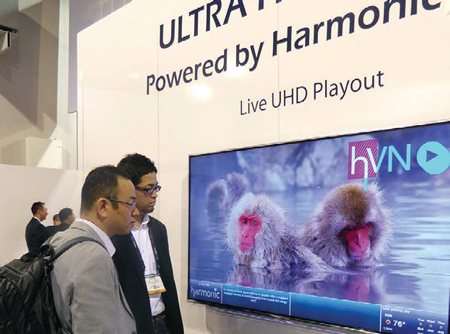NAB Show Preps for Technology Evolution

More than 100,000 visitors are expected to roam more than 1 million square feet of exhibit space hosting over 1,700 exhibitors at this year’s show.
LAS VEGAS—At this year’s annual NAB Show, the industry is poised to explore a rush of new technologies—among them that acronym-heavy trio of UHD, HDR and IP—while simultaneously absorbing the effects that may come from one of the biggest shifts in the traditional broadcast business.
When the show floor opens on Monday April 18, the broadcast industry will be in the midst of the nation’s largest broadcast incentive auction ever, a process that will raise many as-yet-unanswerable questions about who will ultimately participate in the auctioning of the 600 MHz broadcast TV airwaves, who will sit the auction out, how the spectrum repack will effect broadcasters and what the potential fallout will be.
“We as broadcasters have to face the fact that our spectrum is getting ever smaller, yet at the end of the day, we are in the content business,” said Jim Ocon, vice president of engineering for KDFW-TV FOX 4 in Dallas. “A lot of folks are apprehensive but I am excited. At the end of the day, the distribution model needs to change.”

DRAWING A LINE
The show itself will address the unknown ramifications of the spectrum issue with sessions like Tuesday afternoon’s “Consequences of the Incentive Auction,” where a panel of speakers will discuss how engineers can best plan and manage the outcomes of the incentive auction in terms of tower reconstruction, antenna and system re-configurations, and channel sharing.
“[The] NAB Show is an ideal venue to hear directly from regulators about where the auction is headed and how broadcasters can prepare,” said Dennis Wharton, executive vice president of communications for NAB, pointing to guidance that might be found in sessions like “Making it Back Down the Mountain: Repacking Broadcasters Following a Successful Incentive Auction.”

There’s also a revolution happening inside the building, as broadcast facilities work to determine how deep IP technologies can be deployed. Sessions like “Can IP Dominate in Broadcast Facilities?” will attempt to ferret out which functionalities can migrate to IP and which—to be honest— remain islands solidly dependent on legacy broadcast technologies, be it switching, transmission, storage or security.
The professional video industry's #1 source for news, trends and product and tech information. Sign up below.
That has not quelled interest, however, in a burst of IP-related announcements as companies as disparate as Evertz—with its ASPEN IP protocol, Grass Valley—which is helping to lead the effort towards an open IP broadcast standard with AIMS (Alliance for IP Media Solutions) or Calrec—with audio/video IP support equipment based on AES67—use the NAB Show as the base for debuting products.
“We’re drawing a line in the sand with these products,” said Dave Letson, vice president of sales for U.K.-based Calrec. “We had held back on publically stating Calrec’s formal direction on [audio over IP] until we had properly assessed the market and talked to our customers.”

A growing number of manufacturers have also begun to join forces with organizations like the Advanced Media Workflow Association (AMWA), who have introduced initiatives to support the industry’s move towards file-based workflows based on AAF, BXF, MXF & XML standards.
Broadcasters investing in IP infrastructure are able to achieve flexibility and results that were simply not possible in the traditional SDI infrastructure, according to Brad Gilmer, executive director of AMWA. When one considers that IP infrastructures allow broadcasters to scale operations up or down and use commodity hardware— rather than purpose-built devices specifically tailored for our industry—“all of these add up to a flexible, agile and cost-effective way of managing a media business,” Gilmer said. A number of companies at the NAB Show are participating in the company’s Networked Media Incubator project, a framework for creating interoperable and open specifications for IP infrastructures.

Broadcasters are also contending with the ongoing melding of traditional broadcast with OTT technology, as an ever-growing number of viewers move beyond the traditional TV schedule experience and instead are turning regularly to on-demand for more individually tailored experiences. A recent study by the video platform provider Ooyala forecasts that traditional linear channels will become secondary options in the face of operator OTT services, catch-up TV and multi-channel networks.
This year also marks an ever-wider adoption of cloud-based technologies to handle more than just remote storage: consider the availability of cloud-based platform-as-a-service offerings, content delivery networks that offer cloud PVR functionality and mass digitization migration services via the cloud.
A VIRTUAL, DRONE-FILLED FUTURE
Broadcasters are also working to understand the role that new technologies—like virtual reality and unmanned aerial vehicles—should be playing in a broadcasting future.

“Although the technology may not be mainstream today, it could very well be the next big thing for broadcasters,” Wharton said. “That will depend on consumer demand and advances in technology, although it’s definitely taking off in other media sectors, like gaming.” If ATSC 3.0 is adopted, he said, that could be a catalyst for wider implementation of VR and augmented reality (AR) by television broadcasters.
A small but growing group of broadcasters want to use unmanned aircraft for reporting, but adoption of these buzzing tools has been tethered in by FAA rules, requirements and potential fines. It’s been said that 2016 could be a “breakout year” for the use of drones in broadcast technology, but are the devices ready for primetime broadcast use?
Absolutely, said Eric Jameson, product manager of Stampede, a professional AV distribution company of drones and unmanned aerial vehicles—and one of nearly 30 companies exhibiting at the NAB Show Aerial Robotics and Drone Pavilion in the Central Hall of the LVCC. “It’s a matter of broadcast operators preparing to integrate new technology into their already established production system,” he said. “In the broadcast technology market, the opportunity for drone integration is enormous. Outlets can integrate drones into the scene as a ‘floating camera’ for taking aerial shots along with traditional cameras.

With consumer electronics manufacturers phasing out HD in favor of UHD, NAB Show attendees will be scouring the show floor for new 4K solutions.
“In order to make this a reality, though, ground station integration needs to be sufficiently planned out,” Jameson continued, pointing to the need for the development of a mobile control room that can integrate feeds from a group of drones deployed in the sky.
The Drone Pavilion will include an indoor flying drone cage, and Super Sessions such as “Drones: Opening New Vistas to Content,” where panelists will review FAA guidelines and share guidelines for using drones for news.
“Drones already have useful newsgathering capabilities and could be a cost-effective option for stations, especially compared to helicopters,” Wharton added. “The challenges are mainly regulatory.”
NAB Show Previews ATSC 3.0
With industry players big and small making their way to Las Vegas for the 2016 NAB Show, ATSC 3.0 looks to make its presence felt. Attendees will be able to get a preview of the next-gen broadcast standard and learn about how it will directly affect them, on the exhibit floor and conference halls.
The events will kick off on April 16 with SBE’s Ennes Workshop which is focusing its entire day of sessions on the emerging standard.

The full day event is scheduled to feature panels covering a range of ATSC 3.0 topics, including “What You Need for ATSC 3.0–What’s Different from 1.0,” “Immersive & Personalized Audio in ATSC 3.0,” “ATSC 3.0 PHY–Configurations/ Coverage” and more. Other panels during the workshop will cover UHDTV, IP and unmanned aerial systems. Speakers will include Skip Pizzi, senior director of new media technologies for the NAB, Dr. Richard Chernock, chair of the ATSC Technology Group, John Poray, executive director for the Society of Broadcast Engineers, Luke Fay from Sony, who chairs the specialist group on the Physical Layer for ATSC 3.0, Jay Adrick, a consultant for GatesAir, who also chairs the ATSC Advanced Emergency Alerting (AEA) Implementation Team and Kent Walker from Qualcomm.
ATSC 3.0 also plans to have a presence on the exhibit floor in the upper level of the South Hall. At one end will be the “ATSC 3.0 Consumer Experience,” which will showcase the standard’s capabilities like interactive advertising, advanced emergency alerting, expanded audio and 4K video with HDR. In the NAB Futures Park area will be the ATSC 3.0 Broadcast Pavilion, featuring equipment that is designed to help with the introduction of ATSC 3.0 services.
For a comprehensive overview of TV Technology’s ATSC 3.0 coverage, visit www.tvtechnology.com/ATSC3.
Michael Balderston
MORE, BETTER PIXELS
This year, 4K technologies are taking a significant leap forward with new product introductions from manufactures in every major equipment category: cameras, lenses, storage, switchers and asset management, among others. In the fall, NASA partnered with Harmonic to launch the first consumer UHD channel in North America— NASA TV UHD—that sources ultra high-definition video from remastered historical footage and from the International Space Station.
“4K is well underway in movie production, 4K program origination is slowly getting underway in high-end episodics and drama television production, and the exploration of 4K UHD for sports production—which was the great driver of HDTV—is now getting underway,” said Larry Thorpe, a senior fellow with Canon USA.
But for the industry to embrace significant 4K adoption, much remains to be done. “Broadcasters and cable operators [are still] reluctant to make the very costly investment in infrastructure to manage and deliver 4K,” Thorpe said, pointing to an unclear return on investment, the ongoing testing of ATSC 3.0 for 4K UHD delivery, and unresolved industry debate on the degree of improvement to the home viewing experience.
Canon is one manufacturer seeing interest in 4K from established television delivery services, particularly OTT organizations like Netflix and Amazon, and those who are looking to protect the long-term shelf life of their program masters.
Adoption of the technology is being hindered by those familiar snags: consumer confusion about UHDTVs, broadcasters’ hesitancy about ROI, post production expense, and the size of home display screen sizes that end up limiting the “wow factor” of 4K, Thorpe said.
At the NAB Show, attendees will find a series of 4K sessions that will look at protecting 4K content and those that look at the state of production.
This year’s show will be one of the biggest in more than a decade. More than 100,000 attendees are expected to descend on Las Vegas this year covering nearly one million square feet of exhibit floor populated by more than 1,700 exhibitors. International visitors are expected to make up a sizeable chunk of the attendees, with more than 26,000 visitors coming from outside the United States in 2015.
For more information, visit www.nabshow.com.
Susan Ashworth is the former editor of TV Technology. In addition to her work covering the broadcast television industry, she has served as editor of two housing finance magazines and written about topics as varied as education, radio, chess, music and sports. Outside of her life as a writer, she recently served as president of a local nonprofit organization supporting girls in baseball.

